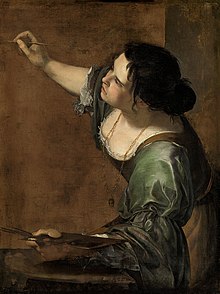Artemisia Gentileschi
Artemisia Gentileschi (July 8, 1593 – c. 1656) was an Italian Baroque painter.
Artemisia Gentileschi | |
|---|---|
 | |
| Born | 8 July 1593 |
| Died | c. 1656 |
| Nationality | Italian |
| Known for | Painting |
| Notable work | |
| Style | Baroque |
| Movement | Accademia delle Arti del Disegno |
| Children |
|
| Patron(s) | |
| Signature | |
Gentileschi was born in Rome in 1593. This was at the start of Baroque painting. She was the first child of the Tuscan painter Orazio Gentileschi. Artemisia trained in his workshop for a number of years before making works herself.[1] She was influenced by the painter Caravaggio.[2]
Gentileschi's first signed and dated painting was Susanna and the Elders. It was dated 1610, which was when she was 17. In 1616, Gentileschi became the first woman member of the Accademia del Disegno (the Florentine Academy of Art).[3]
Her most well-known painting is Judith Beheading Holofernes.[4]
Gentileschi moved to Naples in 1630[5][3] and visited London, England in 1639. Gentileschi died in Naples, but the exact date is unknown. It was some time after 1654.[5]
Legacy
changeGentileschi was not included in the history of 17th-century art after her death. Many of her paintings were thought to have been made by her father or students of Caravaggio.[6] Scholars started paying attention to her work in the early 1900's. In the 1970s she became a champion of second wave feminist art historians.[2] Artist Judy Chicago included a place setting for Gentileschi in the 1979 art installation The Dinner Party.[6]
In 2020, the National Gallery, London held a retrospective of Gentileschi's work entitled Artemisia.[7]
Gentileschi's work is in museums including the Museo del Prado in Madrid,[8] the Metropolitan Museum of Art in New York City,[9] the Uffizi in Florence, Italy,[10] and the National Gallery, London.[7]
Gallery
change-
Susanna and the Elders, 1610
-
self-portrait, around 1615
-
Judith and her Maidservant, between 1618 and 1619
-
Judith Beheading Holofernes around 1620
Related pages
changeReferences
change- ↑ Kleiner, Fred S. (2005). Gardner's Art through the Ages (13 ed.). Wadsworth, Cengage Learning. pp. 661–662.
- ↑ 2.0 2.1 "Gentileschi". The Art Story. Retrieved 11 August 2023.
- ↑ 3.0 3.1 "Artemisia Gentileschi: the Woman, the Artist". Getty. Retrieved 11 August 2023.
- ↑ "Gentileschi, Artemisia: Judith and Her Maidservant (1612-3) - Great Works - Art - The Independent". Archived from the original on 2015-05-02. Retrieved 2017-08-30.
- ↑ 5.0 5.1 "Artemisia Gentileschi (1593 - 1654 or later)". National Gallery, London. Retrieved 11 August 2023.
- ↑ 6.0 6.1 "Artemisia Gentileschi". The Brooklyn Museum. Retrieved 11 August 2023.
- ↑ 7.0 7.1 "Artemisia | Past exhibitions". National Gallery, London. Retrieved 11 August 2023.
- ↑ "Gentileschi, Artemisa". Museo del Prado. Retrieved 12 August 2023.
- ↑ "Artemisia Gentileschi | Esther before Ahasuerus". The Metropolitan Museum of Art. Retrieved 12 August 2023.
- ↑ "Judith Beheading Holofernes by Artemisia Gentileschi". Uffizi Galleries. Retrieved 12 August 2023.
Other websites
change- Media related to Artemisia Gentileschi at Wikimedia Commons
- Artemisia Gentileschi: "The Spirit of Caesar in the soul of a woman!" video by the National Gallery